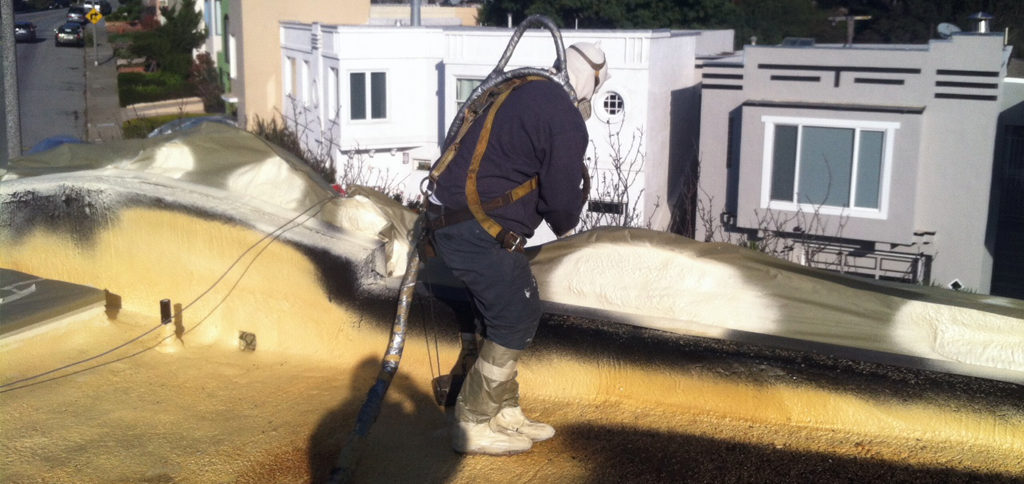The Spray Polyurethane Foam (SPF) Roofing System, commonly known as foam roofing, is the best roofing alternative for flat and low-sloped roofs, for both residential and commercial buildings, in San Francisco and the Bay Area, including Oakland and Fremont. Due to the immense benefits of installing SPF Roofing, it has become quite a popular choice among Bay Area residents. Consequently, the number of companies or contractors, who offer to install this superior roofing system, has increased in recent years. However, home and business owners need to be aware of the importance of the SPF installation process before deciding who to hire to install their new roofing system.
As we have mentioned in previous posts (07 Mar and 06 May), your SPF Roofing system will only be as good as the individuals who install it. The SPF roofing installation is a specialized process that should be performed by experienced professionals who adhere to proper handling and installation techniques, as well as following the necessary safety precautions. With 4 decades of foam roofing experience in the Bay Area, Armstrong Foam Roofing can proudly say we have installed more residential foam roofs than anyone in the United States. You should only trust professionals with a high degree of technical knowledge and experience who will conduct your SPF installation under ideal weather conditions and on well-prepared surfaces to ensure the material bonds to your roof properly.
Steps For Proper Installation
The benefits of your SPF roofing system may be numerous but they can only be optimized when the installer is using proper and safe procedures. Your SPF roofing system is basically created onsite during the installation process, therefore there must be specific guidelines and techniques to be followed. Armstrong Roofing, with its decades of experience, has perfected the SPF installation process into a science. All our customers can be assured that all our crews will follow the same 10 Step Process every single time they install an SPF roofing system.
Pre-Installation Procedures
At Armstrong Roofing, an Installation Department Technician performs a pre-site inspection to investigate the substrate to which the foam will need to adhere and determine the scope of the project. Following that, all job-related permits must be secured before the SPF installation can begin. Furthermore, before the foam is applied, the surface must be dry and free of oils, grease, dirt and debris that could affect the adhesion of the foam. As a result, the roof is broom cleaned and prepared as necessary. In some cases, it may be necessary to tear off up to 2 layers of roofing materials, or more if required, to conform with City Codes.
It may also be necessary to prime the substrate surface to ensure effective adhesion of the foam with the roofing material. Priming is an important component of the process since it helps seal porous substrates, inhibit corrosion of metal substrates, which darken the substrates and increase solar heat gain, and remove moisture. In some cases, it may be required by law to install a Class A substrate before the spraying process. Also, in the rare cases where metal edges, stacks and vents are in poor condition, it may be necessary to replace them. Finally, it’s important to determine the weather conditions on the day of the application since according to the SPFA guidelines, the foam and protective coating should not be installed when there is ice, frost, surface moisture or visible dampness present on the surface to be covered.
Applying The Armstrong Weather-Guard SPF Roofing System
The Armstrong Weather-Guard polyurethane foam is sprayed as a liquid onto the roof surface but in three seconds it rises to 1.5 inches. The foam hardens within a minute and can then be walked on. After hardening, the foam forms a monolithic cellular membrane covering the entire roofing system. This seamless SPF membrane can easily and effectively fill voids, holes and low areas to enhance drainage and increase stability. What’s more, sealing around difficult roof features such as skylight windows or circular exhaust vents can be accomplished quite easily.
Once the polyurethane foam is applied, 2 layers of acrylic elastomeric coating are applied to ensure complete protection against UV degradation. Finally, before the last layer of elastomeric coating dries, a layer of durable ceramic granules is infused into it to create a super-strong seamless impenetrable waterproof roofing system. If properly maintained this superior roofing system is sustainable for up to 50 years and can help you reduce your heating and cooling costs up to 40%. Of course, with Armstrong’s 15-year warranty coverage, your property will be weather protected which also increases property value.
To find out more about our SPF roofing system and its installation process, call Armstrong Foam Roofing today. We offer a no-obligation quote and can arrange a free consultation to show you why SPF Roofing is the best investment for your home or business.

